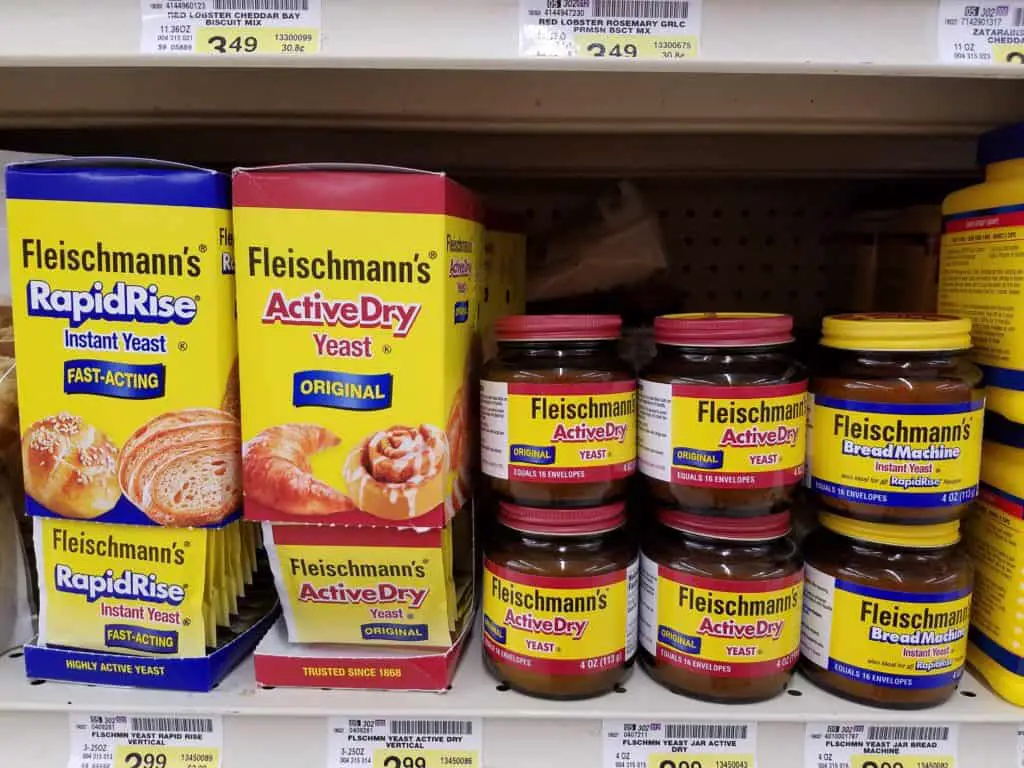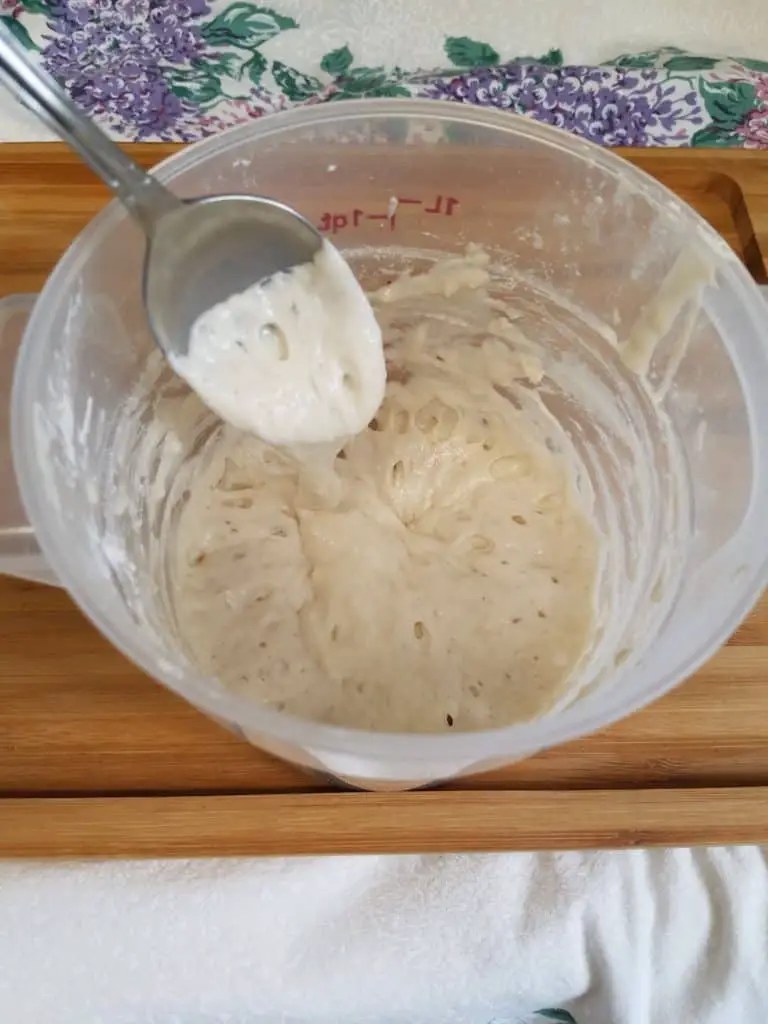Bread and pastries can be leavened in several ways. Quick breads, such as banana bread or soda bread, rely on ingredients like baking soda, baking powder, and/or eggs. Other baked goods, like pizza, sweet rolls, and bread, are leavened using yeast. But there are still different options within this category. For example, when we talk about “yeast breads”, we may mean one of two things; “yeast” meaning, the stuff we buy in a store, or “yeast” meaning sourdough starter, or some other naturally created leavening product.
So what’s the big deal about these different ingredients? Is there a difference between yeast and sourdough starter? Can they be used interchangeably in a recipe?
When bakers refer to yeast they usually are referring to commercially made yeast, which is created in carefully controlled factory conditions. It comes in three forms: instant, active dry, and fresh. “Sourdough starter”, on the other hand, is a home-made product using flour, water, and either a portion of a previously created starter or just the naturally occurring yeast that lives in the air around us.
While fresh yeast is harder to find in the United States, active dry and instant yeast are available in the baking section of most supermarkets. They are dry and powdery, and not much is needed to make dough rise in a relatively short period of time. In other words, they are convenient and fast.
Sourdough looks like a very thick batter. When baking bread with it, more of it and more time are needed for it to properly raise the bread dough. It takes a lot more work and time to create and use a sourdough starter, but the end result is a tastier, healthier loaf of bread. Since yeast and sourdough starter are so different, it takes a lot of calculation and knowledge about baking percentages to use one instead of the other in a recipe. For this reason it’s not recommended for inexperienced bakers to try to use them interchangeably.
Whew, that was a lot! Let’s try to unpack and explain some of that info.
As we go through the differences between these two leavening products, it’s not my intention to try to convince you to use one over the other. There are pros and cons to using each one. I hope that learning more about them will help you decide which one is best for you right now.
The Scoop on Yeast

As I mentioned above, when we use the word “yeast” most of us think of the stuff we get in the grocery store. Let’s look at the three different types of commercially made yeast already briefly mentioned, beginning with the two most commonly found.
Instant Yeast – This type of yeast is sometimes also called “rapid rise” or “bread machine” yeast. It’s easy to find in supermarkets. Often it comes in pre-measured envelopes or in small tubs. Instant yeast is a dry powder. Because it is so fine, it can be added directly to the dry ingredients without needing to first be dissolved in water. As the name implies, it is a fast-acting yeast. Dough made with instant yeast will rise very quickly. Unfortunately, this sometimes means that bread made with instant yeast doesn’t have as much flavor. This is why other ingredients, like oil, butter, sugar, or honey, are often used in recipes calling for instant yeast.
(Side note: something I’ve learned about baking bread is, time = flavor. The more time dough takes to rise, the more flavor will be in the final loaf of bread. This might seem like a side tangent, but it will help answer the original question of the difference between yeast and sourdough starter.)
Active Dry Yeast – This type of yeast is also very easy to find in grocery stores, and also usually comes in envelopes or small tubs. Like instant yeast, it is a dry, shelf-stable product. (Open containers do need to be stored in the fridge. However, they will keep for several weeks). But instead of being a powder, it comes in little granules. As a result, active dry yeast usually needs to be dissolved in liquid before being added to a recipe. It works a little more slowly than instant yeast does and therefore tends to yield more flavorful breads. However, oil and sugar are still often called for in active dry yeast recipes. It’s a very easy and predictable ingredient to work with.

Fresh Yeast – Also known as cake, wet or compressed yeast, fresh yeast is quite different than instant or active dry. It comes in the form of small, moist blocks. It looks a bit like a stick of butter, or a chunk of modeling clay, and has a similar texture. More fresh yeast is needed per loaf of bread being made (2 oz, according to the Red Star Yeast website) than the other two types of yeast. It’s also a lot more difficult to find in grocery stores, and has a very limited shelf life. For this reason, most recipes written for home bakers don’t call for fresh yeast.
Although all three of these types of yeast are pretty different, they all have some similarities. They are ready-made, which makes them convenient to keep and use. They’re predictable, which means you can expect the same results from them every time. And they’re really just another ingredient like flour, sugar, or eggs.
So now that we’ve talked about yeast, let’s look at sourdough starter and how it’s different from yeast.
Sourdough Starter

First, what is sourdough starter? Basically, it’s dough that has been fermented with wild yeast and bacteria. It’s a home-made product.
Other terms you may come across are biga, poolish, sponge, and levain. These are different types of starters that have technical differences in their creation and use, but essentially are all fermented doughs created with flour, water, and wild bacteria and yeast.
Sourdough starters are made by combining flour with water, and leaving them out (unrefrigerated) to be inculturated by the yeast and bacteria living in the air. To prevent mold and other yucky stuff from growing, portions of the starter need to be regularly discarded, and the remaining bit refreshed with more flour and water. This process usually takes 1 – 2 weeks. And although the rations may change, it needs to be continued indefinitely. Because the power of sourdough starter to make bread rise lies in those live and active cultures, they need to be continually cared for in this way. In some ways, it’s less of an ingredient and more of a pet.

When baking with sourdough starter, a much larger amount is needed in order to effectively rise the dough. Think around 1 cup, as opposed to the 2 ¼ teaspoons of active dry yeast! It also takes longer for sourdough starter to rise. It isn’t unusual for sourdough recipes to need 24 hours or more of total rise time.
Because sourdough starter is a living ingredient, it’s a bit more finicky. You can’t just use it whenever the urge to bake strikes. For example, trying to use starter that’s just been discarded and fed will result in a really weak, wimpy rise. This is because the yeast culture has just been diluted and hasn’t had a chance to grow and multiply. On the other hand, using starter that hasn’t been fed in a while may not work well, either. Again, the yeast and bacteria culture may not be strong enough to make the bread dough rise. So as a result, baking with sourdough starter takes a bit more planning and forethought.
With all that being said, why would anyone bother about baking with sourdough starter?
First, because sourdough starter takes so much longer to raise the dough, that results in a much more flavorful loaf of bread. And that means that (more expensive, less healthy) ingredients, like oil and sugar, aren’t needed. Most sourdough bread recipes call for flour, water, salt, and the starter (which, remember, is itself just made of flour and water). So more flavor, with less ingredients. Win!

In addition to sourdough bread being healthier because of a lack of other ingredients, it’s also healthier because the acids created by the wild yeast and bacteria cultures help break down the flour proteins better, resulting in a bread that’s easier for our bodies to digest.
And finally, there’s the satisfaction of baking using a method that’s been used for 1000’s of years. In our fast-paced, instant, globalized world, there’s something really satisfying about baking bread the old-fashioned way.
To answer the second question posed at the beginning, “Can yeast and sourdough be used interchangeably”, the answer is, Not really.
As we discussed, a LOT more sourdough is needed to make bread rise than commercial yeast. And it has a much higher water content than even cake yeast has. So just swapping out yeast for sourdough, or vice-versa, isn’t going to work.
However, it is possible to convert a recipe from commercial yeast to sourdough. This video does a great job of explaining how to do it (I thought all the writing on the whiteboard in the thumbnail picture was a joke. It’s not.) Personally, I don’t think it’s worth the trouble when there are so many different recipes out there. But if you’d like to give it a try, know that it can be done!
Let’s Review
So here’s a quick summary of the similarities and differences between yeast and sourdough starter:
Yeast:
- Purpose: Makes bread rise
- Comes in: instant, active dry, and cake forms
- Convenience level: High. Is ready to use from the store, can be used at any time, no upkeep is needed aside from proper storage
- Amount needed per loaf of bread: Little
- Time needed to work: Little
- Flavor produced: Little
- Health benefits: Low
- Recipes to try: King Arthur Flour’s Sandwich Bread, Smitten Kitchen’s Cranberry Orange Breakfast Buns, Bobby Flay’s Pizza Dough, Sally’s Baking Addiction Soft Dinner Rolls
Sourdough Starter:
- Purpose: Makes bread rise
- Related to: poolish, biga, levain, sponge
- Most commonly used in: artisan-style bread loaves
- Convenience level: Low. Must be made from scratch (over the course of several days), tended to regularly, and can only be used at certain times
- Amount needed per loaf of bread: A lot
- Time needed to work: A lot
- Flavor produced: A lot
- Health benefits: High
- Recipes to try: The Pioneer Woman’s Sourdough Bread, King Arthur Flour’s Whole Grain Sourdough, Breadtopia’s Sourdough Pizza, Nourishing Days’ Easy Overnight Sourdough Rolls

